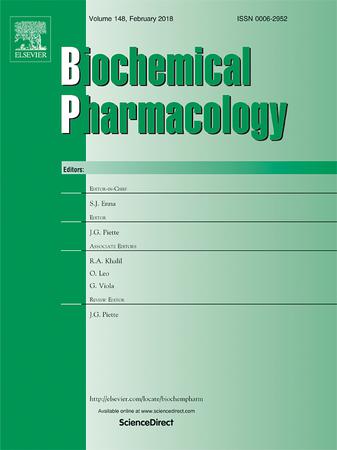From stem cells to skin: ADSCP6 peptide’s role in transforming scar therapy
IF 5.6
2区 医学
Q1 PHARMACOLOGY & PHARMACY
引用次数: 0
Abstract
Hypertrophic scars, caused by abnormal wound healing after injury, involve excessive fibroblast activity, ECM dysregulation, and inflammation. Bioactive peptides show antifibrotic potential. Based on our previous discovery of scar-modulating peptides from adipose-derived stem cells, this study reveals how ADSCP6 (Adipose-derived stem cell peptide 6) suppresses hypertrophic scarring. In vitro analyses revealed that ADSCP6 significantly downregulated type I collagen and ACTA2 (alpha smooth muscle actin) expression in human hypertrophic scar fibroblasts (HSFs), without altering proliferative/apoptotic activity. In vivo, topical ADSCP6 administration enhanced wound healing and attenuated collagen content in a murine excisional wound model. Transcriptomic profiling (RNA-seq) identified 328 differentially expressed genes (182 upregulated, 146 downregulated) post-treatment, with KEGG (kyoto encyclopedia of genes and genomes) pathway enrichment implicating NF-κB (nuclear factor kappa-B) signaling as a primary mechanism. Protein interaction assays (pull-down/cellular thermal shift assays) identified KANK2 (KN motif and ankyrin repeat domains 2) and ADGRE2/EMR2 (adhesion G protein-coupled receptor E2) as ADSCP6-binding partners, while western blot confirmed NF-κB1 (p50) upregulation. Functional validation demonstrated that NF-κB pathway blockade abrogated ADSCP6′s antifibrotic effects. ADSCP6 reduced the expression of FAK, STAT3, and SMAD2 proteins. Macrophage-conditioned media from ADSCP6-treated cultures suppressed HSFs collagen synthesis, and ADSCP6 significantly enhanced HUVEC (human umbilical vein endothelial cells) tubulogenesis, suggesting pro-angiogenic activity. Overall, these findings establish ADSCP6 as a multifunctional therapeutic peptide that concurrently attenuates fibrotic progression and accelerates wound healing, positioning it as a novel candidate for clinical scar management.

从干细胞到皮肤:ADSCP6肽在转化疤痕治疗中的作用
增生性疤痕是由外伤后伤口愈合异常引起的,涉及成纤维细胞活性过度、ECM失调和炎症。生物活性肽具有抗纤维化的潜力。基于我们之前从脂肪来源的干细胞中发现的疤痕调节肽,本研究揭示了ADSCP6(脂肪来源的干细胞肽6)如何抑制肥厚性瘢痕形成。体外分析显示,ADSCP6显著下调人增生性瘢痕成纤维细胞(hsf)中I型胶原和ACTA2 (α平滑肌肌动蛋白)的表达,但不改变增殖/凋亡活性。在体内,局部给药ADSCP6促进了小鼠切除伤口模型的伤口愈合并降低了胶原蛋白含量。转录组学分析(RNA-seq)鉴定出328个差异表达基因(182个上调,146个下调),KEGG(京都基因和基因组百科全书)途径富集,暗示NF-κB(核因子κ b)信号传导是主要机制。蛋白相互作用实验(下拉/细胞热移实验)发现kk2 (KN基序和锚蛋白重复结构域2)和ADGRE2/EMR2(粘附G蛋白偶联受体E2)是adscp6的结合伙伴,而western blot证实NF-κB1 (p50)上调。功能验证表明NF-κB通路阻断可消除ADSCP6的抗纤维化作用。ADSCP6降低了FAK、STAT3和SMAD2蛋白的表达。ADSCP6处理培养的巨噬细胞培养基抑制hsf胶原合成,ADSCP6显著增强HUVEC(人脐静脉内皮细胞)小管形成,提示促血管生成活性。总之,这些发现表明ADSCP6是一种多功能治疗肽,可同时减缓纤维化进展并加速伤口愈合,使其成为临床疤痕治疗的新候选药物。
本文章由计算机程序翻译,如有差异,请以英文原文为准。
求助全文
约1分钟内获得全文
求助全文
来源期刊

Biochemical pharmacology
医学-药学
CiteScore
10.30
自引率
1.70%
发文量
420
审稿时长
17 days
期刊介绍:
Biochemical Pharmacology publishes original research findings, Commentaries and review articles related to the elucidation of cellular and tissue function(s) at the biochemical and molecular levels, the modification of cellular phenotype(s) by genetic, transcriptional/translational or drug/compound-induced modifications, as well as the pharmacodynamics and pharmacokinetics of xenobiotics and drugs, the latter including both small molecules and biologics.
The journal''s target audience includes scientists engaged in the identification and study of the mechanisms of action of xenobiotics, biologics and drugs and in the drug discovery and development process.
All areas of cellular biology and cellular, tissue/organ and whole animal pharmacology fall within the scope of the journal. Drug classes covered include anti-infectives, anti-inflammatory agents, chemotherapeutics, cardiovascular, endocrinological, immunological, metabolic, neurological and psychiatric drugs, as well as research on drug metabolism and kinetics. While medicinal chemistry is a topic of complimentary interest, manuscripts in this area must contain sufficient biological data to characterize pharmacologically the compounds reported. Submissions describing work focused predominately on chemical synthesis and molecular modeling will not be considered for review.
While particular emphasis is placed on reporting the results of molecular and biochemical studies, research involving the use of tissue and animal models of human pathophysiology and toxicology is of interest to the extent that it helps define drug mechanisms of action, safety and efficacy.
 求助内容:
求助内容: 应助结果提醒方式:
应助结果提醒方式:


